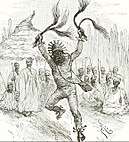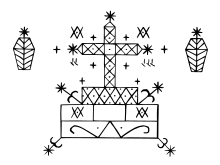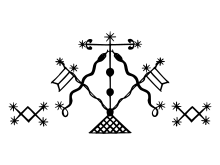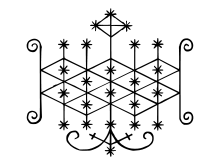Veve
| Part of a series on Vodun related religions called |
| Voodoo |
|---|
 |
|
Deities |
A veve (also spelled vèvè or vevè) is a religious symbol commonly used in different branches of voodoo throughout the African diaspora such as Haitian voodoo. Veves should not be confused with the patipembas used in Palo or the pontos riscados used in Umbanda and Quimbanda since these are separate African religions. The veve acts as a "beacon" for the Loa, and will serve as a loa's representation during rituals.
History
Their origin is unknown and conflicting. A few have thought that the veve was derived from the beliefs of the Indigenous Taíno people, but it is commonly believed to have possibly originated from the cosmogram of the Kongo people, or originated as the Nsibidi system of writing for the Igboid and Ekoid languages from West and Central Africa.[1][2]
Function
According to Milo Rigaud "The veves represent figures of the astral forces... In the course of Vodou ceremonies, the reproduction of the astral forces represented by the veves obliges the loas... to descend to earth." [3]
Every loa has his or her own unique veve, although regional differences have led to different veves for the same loa in some cases. Sacrifices and offerings are usually placed upon them, with food and drink being most commonly used.
Presentation
In ritual and other formalities, veve is usually drawn on the floor by strewing a powder-like substance, commonly cornmeal, wheat flour, bark, red brick powder, or gunpowder, though the material depends entirely upon the ritual. In Haitian Vodou, a mixture of cornmeal and wood ash is used.
Veve can be made into screenprint, painting, patchwork etc., as wall hangings, artworks, and banners.
Examples
 Veve of Ayizan
Veve of Ayizan Veve of Baron Samedi
Veve of Baron Samedi Veve of Maman Brigitte
Veve of Maman Brigitte Veve of Damballah Weddo
Veve of Damballah Weddo Veve of Papa Legba
Veve of Papa Legba Veve of Ogoun
Veve of Ogoun
See also
References
- ↑ University of Southwestern Louisiana (1987). Baking in the Sun: Visionary Images from the South. University of Southwestern Louisiana. p. 30.
- ↑ Asante, Molefi K. (2007). The History of Africa: The Quest for Eternal Harmony. Routledge. p. 252. ISBN 0-415-77139-0.
- ↑ Milo Rigaud, Secrets of Voodoo, City Lights, NY, 1969
External links
| Wikimedia Commons has media related to Veve. |